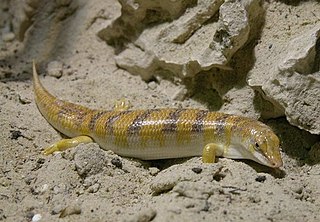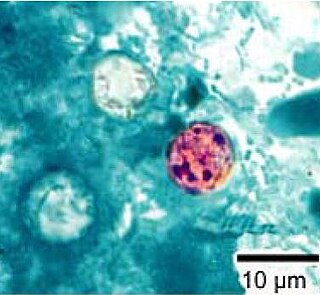Related Research Articles

Teratoscincus is a genus of geckos commonly referred to as wonder geckos or frog-eyed geckos; it is the only genus within the subfamily Teratoscincinae of the family Sphaerodactylidae. Species in the genus Teratoscincus are found from the Arabian Peninsula in Qatar, the United Arab Emirates, and Oman, west across southern Asia in Iran, Afghanistan, and Pakistan, north to Russia, Kazakhstan, Turkmenistan, Uzbekistan, and Tajikistan to Mongolia and China. The genus consists of nine species.
Euprepis is an obsolete genus of skinks in the subfamily Lygosominae. It was named by Wagler in 1830 and frequently used in subsequent years, often misspelled as Euprepes, a misspelling introduced by Wiegmann in 1834. It was then subsumed under the large skink genus Mabuya, until Mausfeld and others resurrected it for a group of mainly African skinks they split from Mabuya. The following year, Bauer argued that this assignment had been in error and that this group should be called Trachylepis instead. Euprepis itself is a junior synonym of Mabuya.

Scincus is a genus of skinks, lizards in the family Scincidae. The genus contains four or five species, all of which are typical desert inhabitants, living in sandy and dune-like areas with a hot and dry climate. Species in the genus Scincus can be found from Arabia to the Sahara desert.

René Primevère Lesson was a French surgeon, naturalist, ornithologist, and herpetologist.

Arend Friedrich August Wiegmann was a German zoologist and herpetologist born in Braunschweig.
Sandfish may refer to:

Scincus scincus, also commonly known as the sandfish skink, common sandfish or common skink, is a species of skink notable for its burrowing or swimming behaviour in sand. It is native to the Sahara Desert and the Arabian Peninsula, but is also kept as a pet elsewhere.

The eastern skink, also known as the Arabian sand skink or the eastern sandfish, is a species of lizard in the skink family, Scincidae. It is endemic to the deserts and arid lands of the east-southeastern Arabian Peninsula north to Western Iran. Truly at home within fine, loosely-grained desert sand, this skink is known for resting while completely buried, keeping only its nostrils, and possibly part of its face, above ground for oxygen. In addition to ambushing passing invertebrate prey, Scincus mitranus will readily "dive" into the sand at the first sign of danger, appearing to "swim" through the dunes as they hastily bury themselves deeper to hide. Their naturally glossy, shiny and smooth scales—typical of the skink family, in general—enable quick digging and rapid movement within the fine, often very hot, substrate, with no external injury or irritation to their bodies. This behavior has earned S. mitranus its common names of "sandfish" and "sand skink".

Scincinae is a subfamily of lizards. The subfamily contains 33 genera, and the genera contain a combined total of 284 species, commonly called skinks. The systematics is at times controversial. The group is probably paraphyletic. It is one of three subfamilies of the family Scincidae, the other two being Acontinae and Lygosominae.

Trachylepis homalocephala, commonly known as the red-sided skink, is a small, slender species of skink in the subfamily Mabuyinae.

Cyclospora is a genus of apicomplexan parasites. It includes the species Cyclospora cayetanensis, the causative agent of cyclosporiasis. Members of Cyclospora are characterized as having oocysts with two sporocysts, each containing two sporozoites.
Parazosmotes is a genus of longhorn beetles of the subfamily Lamiinae, containing the following species:

Teratoscincus scincus, commonly referred to as the common wonder gecko or the frog-eyed gecko, is a species of lizard in the family Sphaerodactylidae. The species is native to arid parts of Asia and has special adaptations which suit it to desert life.
Teratoscincus rustamowi is a small species of gecko, a lizard in the family Sphaerodactylidae. The species is endemic to Uzbekistan.

Scincus albifasciatus is a species of lizard which is found in Senegal, Mauritania, Algeria, and Western Sahara.

Scincus conirostris, a type of sandfish skink, is a species of lizard in the skink family, Scincidae, found in Iran, Oman, Saudi Arabia and the United Arab Emirates.
There are two species of lizard named sandfish skink:
Scincus hemprichii is a species of lizard in the family Scincidae. The species is native to the Arabian Peninsula.
References
- ↑ BioLib.cz - Parazosmotes scincus. Retrieved on 8 September 2014.